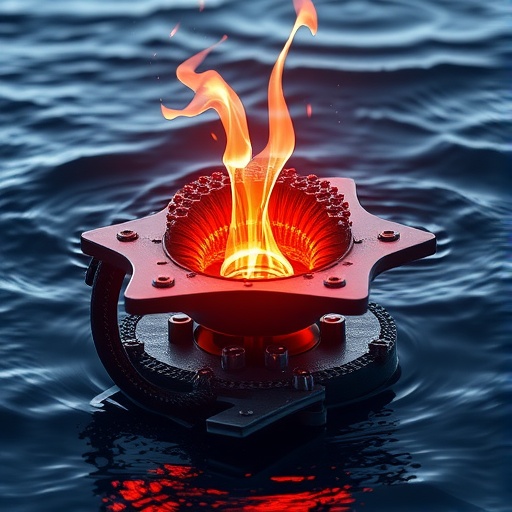As the global quest for green hydrogen intensifies, innovative approaches are increasingly favored to harness the vast and untapped resources of our oceans. Researchers are demonstrating that electrolysis of seawater holds tremendous potential for sustainable hydrogen production. However, the presence of chloride ions in seawater poses significant challenges, as these ions can corrode electrodes, leading to substantial degradation in performance and reduced device longevity. Overcoming these obstacles is pivotal for advancing seawater electrolysis technology toward commercial viability.
Recent investigations spearheaded by Shen and colleagues, outlined in a forward-looking study published in the Journal of the American Chemical Society (JACS) in 2025, reveal breakthroughs in mitigating corrosion through rare-earth oxide engineering. This research highlights the application of europium oxide (Eu₂O₃) coatings on iron–nickel sulfide electrodes, providing a robust and effective shield against the corrosive effects of chlorine produced during the electrolysis process while ensuring high efficiency in hydrogen production.
In this intricate process, the rare-earth compound—Eu₂O₃—serves a dual role: it acts as a protective barrier that significantly inhibits the harmful effects of chloride ions, while simultaneously enhancing the oxygen evolution reaction (OER). Through meticulously designed experiments, including advanced in situ techniques and computer modeling, the researchers demonstrated the effectiveness of the Europium oxide layer, which prevented chlorine-induced corrosion and maintained operational stability. These findings suggest that electrodes treated with the Eu₂O₃ layer achieved a current density that was double that of their uncoated counterparts and demonstrated remarkable endurance, maintaining performance levels for over 1,000 hours under rigorous operational conditions.
Prof. Yangming Lin and his research team delve further into the implications of these findings within their commentary published in Frontiers in Energy. They underscore the importance of atomic-level material engineering in addressing real-world electrochemistry challenges. The integration of various electrochemical characterization techniques allowed for comprehensive understanding and validation of interfacial evolution, essential for assessing the behavior of key intermediate species during the electrolysis process. This multifaceted approach not only enhances our understanding of seawater electrolysis but also addresses broader reactions within electrochemical systems.
The creation of a microenvironment enriched with hydroxide ions—achieved through the unique properties of rare-earth oxides—opens new pathways for advancing corrosion-resistant technologies in seawater electrolysis. Such interfaces are pivotal for stabilizing electrodes, revolutionizing the field and presenting a scalable solution for efficient green hydrogen production, particularly in coastal areas abundant with seawater resources. The implications of these advancements are monumental, potentially driving large-scale adoption and integration of seawater electrolysis into future hydrogen economy frameworks.
Techno-economic analyses from the study indicate that the electrodes protected by the rare-earth oxide coatings can meet profitability targets, underscoring their potential for widespread industrial applications. However, the journey forward is not without hurdles. The research team identifies critical challenges that remain, particularly regarding the longevity and stability of these systems. Real-world seawater electrolysis units are expected to function effectively for at least 10,000 hours under mature operational currents, posing a formidable challenge for sustaining electrode performance over extended periods.
Moreover, the scaling up of this technology presents additional concerns. As researchers strive to transition from laboratory conditions to large-scale implementations, the potential complexity and cost-effectiveness of producing rare-earth oxide coatings need thorough exploration. Future studies, therefore, must investigate the practicalities of both maintaining efficiency and affordability while addressing the real-world challenges of seawater electrolysis.
Despite these challenges, the research conducted by Shen et al. marks a significant step forward in the ongoing quest to make seawater electrolysis, and thereby the production of large-scale green hydrogen, a feasible and economically viable reality. This breakthrough not only advances our understanding of electrochemical processes but also aligns closely with global initiatives aimed at harnessing sustainable energy sources to combat climate change.
With the urgency surrounding our transition to renewable energy solutions, these advancements in seawater electrolysis technology cannot be overstated. They herald a transformative shift in hydrogen production methodologies, paving the way for cleaner energy futures harnessed from the vast oceans that envelop our planet. Researchers believe that the insights gleaned from this study can act as catalysts for future innovations within both electrochemical research and practical applications, fostering pathways toward a sustainable hydrogen economy.
This research illustrates the exciting intersections of chemistry, materials science, and engineering, demonstrating how targeted innovations can address complex environmental challenges. The implications extend far beyond hydrogen production, opening avenues in related fields and driving further scientific inquiry into materials that can withstand challenging conditions while enabling breakthrough technologies.
Overall, the findings from this breakthrough study underscore the critical need for continued investment in research and development within the field of electrochemistry. As scientists investigate more ways to enhance seawater electrolysis and mitigate corrosion, they edge closer to achieving a sustainable solution for hydrogen production that could truly revolutionize the energy landscape and contribute to global efforts in reducing carbon emissions.
In conclusion, this research stands as a testament to human ingenuity and the potential for science and technology to address pressing global challenges. As we delve deeper into understanding the interactions at the molecular level and develop strategies that promote stability and efficiency, the dream of affordable, green hydrogen production will likely transition from aspiration to reality, offering hope for a cleaner, sustainable energy future.
Subject of Research: Seawater Electrolysis and Corrosion Mitigation
Article Title: Rare Earth Engineering to Mitigate Corrosion Challenges in Seawater Electrolysis
News Publication Date: 30-Aug-2025
Web References: 10.1007/s11708-025-1036-y
References: Journal of the American Chemical Society (JACS), Frontiers in Energy
Image Credits: Qingxiu Duan, Chao Luo, Mo Zhang & Yangming Lin
Keywords
Electrolysis, Corrosion Resistance, Green Hydrogen, Rare Earth Engineering, Seawater Electrolysis, Sustainable Energy.




